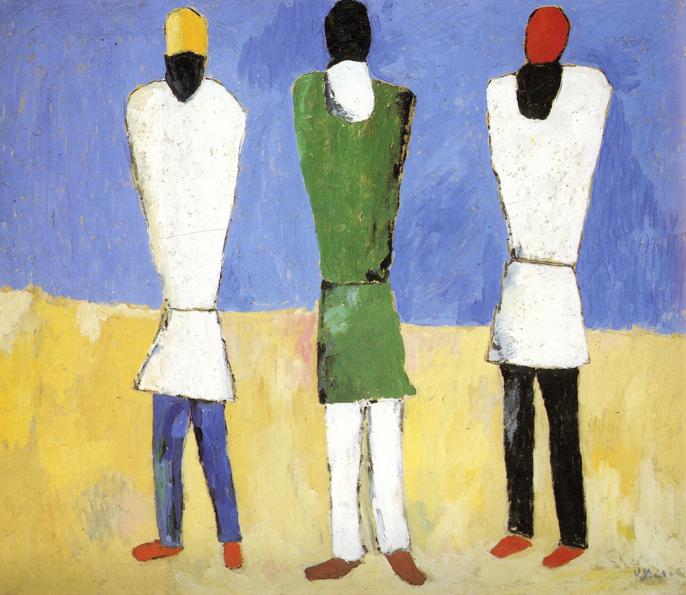Description
Kazimir Malevich, one of the banners of avant -garde art in the Russia of the twentieth century, gives us in "peasants - 1932" a visual testimony that simply transcends the representation of rural life. In this work of medium dimensions, Malevich invites the spectator to immerse himself in a space that is at the same time familiar and deeply disconcerting. The composition, although apparently simple, is revealed as a complex reflection on the human condition and the socio -political context of the time.
At first glance, the scene seems to be inhabited by human figures, but these are stripped of any facial detail, made up of geometric shapes that reveal Malevich's supreme inclination. This style, which he himself developed and seeks to transcend picturesque and realism, focuses on the purity of form and color. In "Peasants - 1932", the figures are more recognizable than in their most abstract suprematist works, but significant abstraction is still perceived.
The color scheme is limited but powerful. The figures are dyed in primary and secondary colors, dominated by red, white, black and terrious tones that directly evoke their peasant environment. The use of color is not merely decorative; Red, for example, can be interpreted as an allusion to the revolution and the implementation of communist ideology, while the most terrible tones connect the characters with the earth they work.
The arrangement of the figures in the pictorial plane is fascinating. The peasants are rigid and frontally aligned, almost like religious icons, underlining the dignity and solemnity of their work, but also projecting a feeling of isolation and anonymity. Each figure seems to be lost in their own world, without apparent interaction with the others. It is a mirror of collective isolation that many times marks the human condition.
A more detailed inspection of the image reveals a minimalist rural background, with suggestions of flat landscapes and horizontal lines that divide the sky of the earth. This simple and clear geometry is a reminiscence of Naive painting, although it overlaps with Malevich's modernist austerity. The work lacks any type of ornament; There are no detailed trees, houses or tools that distract the spectator from the centrality of the human figure.
It should be noted that "Peasants - 1932" was created for a turbulent period for Malevich and for the Soviet Union in general. The pressure to conform to the dictates of socialist realism began to intensify, and although this work does not follow the canons of socialist realism, it is not totally abstract either. In this sense, it can be considered a kind of artistic commitment, a work that maintains the experimental integrity of Malevich while responding to the growing government expectations.
"Peasants - 1932" reflects both Malevich's genius and his ability to adapt in change times. It reminds us that the greatness of art does not lie only in its ability to formally innovate, but also in its ability to capture and comment on the complexities of the context in which it occurs. It is a visual reminder of the oppressive reality of Soviet peasants, trapped between the tradition and dictatorship of state regulations. In this work, Malevich presents a silent but eloquent reflection on individuality and community, modernity and history, and inherent tensions in everyday life.
KUADROS ©, a famous paint on your wall.
Hand-made oil painting reproductions, with the quality of professional artists and the distinctive seal of KUADROS ©.
Art reproduction service with satisfaction guarantee. If you are not completely satisfied with the replica of your painting, we refund your money 100%.

